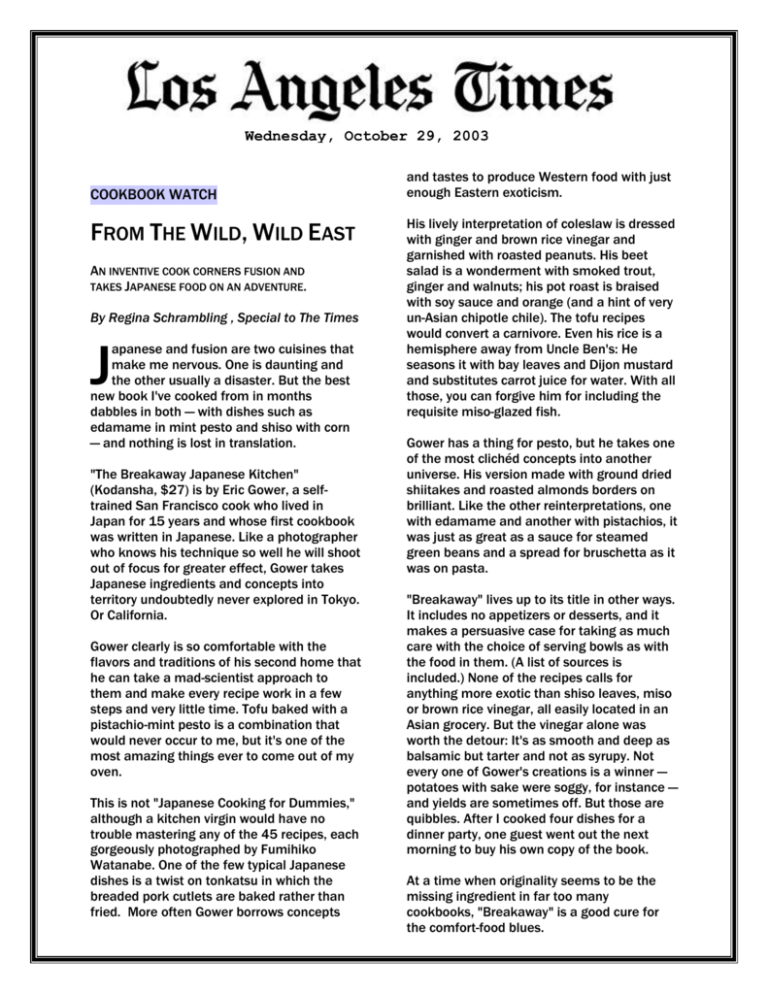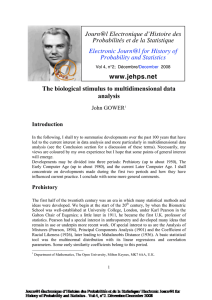cookbook watch - Breakaway Cook
advertisement

Wednesday, October 29, 2003 COOKBOOK WATCH FROM THE WILD, WILD EAST AN INVENTIVE COOK CORNERS FUSION AND TAKES JAPANESE FOOD ON AN ADVENTURE. By Regina Schrambling , Special to The Times J apanese and fusion are two cuisines that make me nervous. One is daunting and the other usually a disaster. But the best new book I've cooked from in months dabbles in both — with dishes such as edamame in mint pesto and shiso with corn — and nothing is lost in translation. "The Breakaway Japanese Kitchen" (Kodansha, $27) is by Eric Gower, a selftrained San Francisco cook who lived in Japan for 15 years and whose first cookbook was written in Japanese. Like a photographer who knows his technique so well he will shoot out of focus for greater effect, Gower takes Japanese ingredients and concepts into territory undoubtedly never explored in Tokyo. Or California. Gower clearly is so comfortable with the flavors and traditions of his second home that he can take a mad-scientist approach to them and make every recipe work in a few steps and very little time. Tofu baked with a pistachio-mint pesto is a combination that would never occur to me, but it's one of the most amazing things ever to come out of my oven. This is not "Japanese Cooking for Dummies," although a kitchen virgin would have no trouble mastering any of the 45 recipes, each gorgeously photographed by Fumihiko Watanabe. One of the few typical Japanese dishes is a twist on tonkatsu in which the breaded pork cutlets are baked rather than fried. More often Gower borrows concepts and tastes to produce Western food with just enough Eastern exoticism. His lively interpretation of coleslaw is dressed with ginger and brown rice vinegar and garnished with roasted peanuts. His beet salad is a wonderment with smoked trout, ginger and walnuts; his pot roast is braised with soy sauce and orange (and a hint of very un-Asian chipotle chile). The tofu recipes would convert a carnivore. Even his rice is a hemisphere away from Uncle Ben's: He seasons it with bay leaves and Dijon mustard and substitutes carrot juice for water. With all those, you can forgive him for including the requisite miso-glazed fish. Gower has a thing for pesto, but he takes one of the most clichéd concepts into another universe. His version made with ground dried shiitakes and roasted almonds borders on brilliant. Like the other reinterpretations, one with edamame and another with pistachios, it was just as great as a sauce for steamed green beans and a spread for bruschetta as it was on pasta. "Breakaway" lives up to its title in other ways. It includes no appetizers or desserts, and it makes a persuasive case for taking as much care with the choice of serving bowls as with the food in them. (A list of sources is included.) None of the recipes calls for anything more exotic than shiso leaves, miso or brown rice vinegar, all easily located in an Asian grocery. But the vinegar alone was worth the detour: It's as smooth and deep as balsamic but tarter and not as syrupy. Not every one of Gower's creations is a winner — potatoes with sake were soggy, for instance — and yields are sometimes off. But those are quibbles. After I cooked four dishes for a dinner party, one guest went out the next morning to buy his own copy of the book. At a time when originality seems to be the missing ingredient in far too many cookbooks, "Breakaway" is a good cure for the comfort-food blues.











